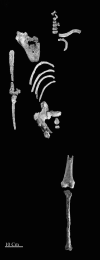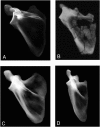An early Australopithecus afarensis postcranium from Woranso-Mille, Ethiopia
- PMID: 20566837
- PMCID: PMC2901440
- DOI: 10.1073/pnas.1004527107
An early Australopithecus afarensis postcranium from Woranso-Mille, Ethiopia
Abstract
Only one partial skeleton that includes both forelimb and hindlimb elements has been reported for Australopithecus afarensis. The diminutive size of this specimen (A.L. 288-1 ["Lucy"]) has hampered our understanding of the paleobiology of this species absent the potential impact of allometry. Here we describe a large-bodied (i.e., well within the range of living Homo) specimen that, at 3.58 Ma, also substantially antedates A.L. 288-1. It provides fundamental evidence of limb proportions, thoracic form, and locomotor heritage in Australopithecus afarensis. Together, these characteristics further establish that bipedality in Australopithecus was highly evolved and that thoracic form differed substantially from that of either extant African ape.
Conflict of interest statement
The authors declare no conflict of interest.
Figures





Similar articles
-
Phylogeny of early Australopithecus: new fossil evidence from the Woranso-Mille (central Afar, Ethiopia).Philos Trans R Soc Lond B Biol Sci. 2010 Oct 27;365(1556):3323-31. doi: 10.1098/rstb.2010.0064. Philos Trans R Soc Lond B Biol Sci. 2010. PMID: 20855306 Free PMC article. Review.
-
New hominid fossils from Woranso-Mille (Central Afar, Ethiopia) and taxonomy of early Australopithecus.Am J Phys Anthropol. 2010 Mar;141(3):406-17. doi: 10.1002/ajpa.21159. Am J Phys Anthropol. 2010. PMID: 19918995
-
Mosaic habitats at Woranso-Mille (Ethiopia) during the Pliocene and implications for Australopithecus paleoecology and taxonomic diversity.J Hum Evol. 2022 Feb;163:103076. doi: 10.1016/j.jhevol.2021.103076. Epub 2022 Jan 5. J Hum Evol. 2022. PMID: 34998271
-
Associated cranial and forelimb remains attributed to Australopithecus afarensis from Hadar, Ethiopia.J Hum Evol. 2005 Jun;48(6):593-642. doi: 10.1016/j.jhevol.2005.02.005. J Hum Evol. 2005. PMID: 15927662
-
Interpreting the posture and locomotion of Australopithecus afarensis: where do we stand?Am J Phys Anthropol. 2002;Suppl 35:185-215. doi: 10.1002/ajpa.10185. Am J Phys Anthropol. 2002. PMID: 12653313 Review.
Cited by
-
A new hominin foot from Ethiopia shows multiple Pliocene bipedal adaptations.Nature. 2012 Mar 28;483(7391):565-9. doi: 10.1038/nature10922. Nature. 2012. PMID: 22460901
-
Phylogeny of early Australopithecus: new fossil evidence from the Woranso-Mille (central Afar, Ethiopia).Philos Trans R Soc Lond B Biol Sci. 2010 Oct 27;365(1556):3323-31. doi: 10.1098/rstb.2010.0064. Philos Trans R Soc Lond B Biol Sci. 2010. PMID: 20855306 Free PMC article. Review.
-
Homo naledi, a new species of the genus Homo from the Dinaledi Chamber, South Africa.Elife. 2015 Sep 10;4:e09560. doi: 10.7554/eLife.09560. Elife. 2015. PMID: 26354291 Free PMC article.
-
Limb Bone Structural Proportions and Locomotor Behavior in A.L. 288-1 ("Lucy").PLoS One. 2016 Nov 30;11(11):e0166095. doi: 10.1371/journal.pone.0166095. eCollection 2016. PLoS One. 2016. PMID: 27902687 Free PMC article.
-
Palaeoanthropology: Australopithecine butchers.Nature. 2010 Aug 12;466(7308):828. doi: 10.1038/466828a. Nature. 2010. PMID: 20703298 No abstract available.
References
-
- Deino AL, et al. (40)Ar/(39)Ar dating, paleomagnetism, and tephrochemistry of Pliocene strata of the hominid-bearing Woranso-Mille area, west-central Afar Rift, Ethiopia. J Hum Evol. 2010;58:111–126. - PubMed
-
- Haile-Selassie Y, et al. Preliminary geology and paleontology of the Woranso-Mille, Central Afar, Ethiopia. Anthropol Sci. 2007;115:215–222.
-
- Haile-Selassie Y, et al. New hominid fossils from Woranso-Mille (Central Afar, Ethiopia) and taxonomy of early Australopithecus. Am J Phys Anthropol. 2010;141:406–417. - PubMed
-
- Johanson DC, et al. Morphology of the Pliocene partial hominid skeleton (A.L. 288-1) from the Hadar Formation, Ethiopia. Am J Phys Anthropol. 1982;57:403–451.
-
- Johanson DC, et al. A new species of the genus Australopithecus (Primates: Hominidae) from the Pliocene of eastern Africa. Kirtlandia. 1978;28:1–14.
Publication types
MeSH terms
LinkOut - more resources
Full Text Sources
Research Materials
Miscellaneous

